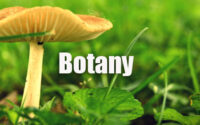Botany Important Question
1. Coenobium type of thallus organization is seen in,
A. Zygnematales
B. Cladophorales
C. Volvocales
D. Dasycladales
2. Which one of the following shall be given priority for conservation?
A. Monotypic genus under EN category
B. A species of a large genus with CR category
C. A species of a large genus with EN category
D. Monotypic genus under CR category
3. Which algal division is divided up into three main groups consisting of the golden-brown algae, the yellow-green algae and the diatoms?
A. Chlorophyta
B. Chrysophyta
C. Phaeophyta
D. Pyrrophyta
4. In accordance with the recommendation of committee on International rules of Botanical Nomenclature the fungus name ending with “mycetidae” belongs to _________.
A. Subdivision
B. Class
C. Subclass
D. Order
5. When there is an increase in the condensation of chromatin during the process of cell division
A. Heterochromatin increases
B. Euchromatin increases
C. Differentiation of euchromatin & heterochromatin decreases
D. Differentiation of euchromatin & heterochromatin increases
6. In a pond ecosystem, the bottom area where the production is lesser than the respiration (P/R<1) is termed as
A. Limnetic zone
B. Profundal zone
C. Benthic zone
D. Tidal zone
7. The “Black 47” is related to….?
A. Great Bengal Famine
B. Irish Famine
C. Famine in Edessa
D. Famine throughout Europe 1016
8. Assemblage of microtubules perpendicular to the spindles at the equator of cell at Telophase is a characteristic feature of
A. All algae
B. Only in Green algae
C. Green algae and Charophytes
D. Green algae and Higher plants
9. The term “ecosystem” was first proposed by
A. A.G. Tansely
B. H.T. Odum
C. Karl Mobius
D. None of these
10. The sequence of the structural genes in the lac operon is
A. lacA-lacZ-lacY
B. lacZ-lacY-lacA
C. lacZ-lacA-lacY
D. lacA-lacY-lacZ
11. Haptonema is Present in
A. Xanthopyceae
B. Prymnesiophyceae
C. Bacillariophyceae
D. All of the above
12. What is the function of the Bacteriophage lambda N gene?
A. It promotes the function of terminators
B. It overrides the function of terminators
C. It promotes the production of the cro gene
D. It is responsible for making the infectious particle linear
13. DNA fingerprinting recognizes the differences in
A. satellite DNA
B. bulk DNA
C. Repetitive DNA
D. both (A) and (C)
14. The stress hormone of the plant is ___________.
A. Brassinosteroid
B. Abscisic acid
C. Cytokines
D. Ethylene
15. Pit connections are present in,
A. All members of Rhodophyceae
B. Only in Florideophyceae
C. Only in Bangiophycideae
D. None of the above
16. As the two strands of the double helix are separated, the positive supercoiling interferes with the further unwinding of DNA. Which of the following enzyme makes a break in a strand of DNA to release the supercoiling and facilitate the replication to occur?
A. DnaA protein
B. Single-strand binding protein
C. DNA polymerase
D. Topoisomerase
17. Which of these subunits of RNA polymerase is totally required to initiate transcription?
A. alpha (α)
B. sigma (σ)
C. omega (ω)
D. beta (β)
18. The two pigment system theory of photosynthesis was proposed by ——–
A. Aron
B. Blackman
C. Hill
D. Emerson
19. The casual organism of wilt of cotton wilt is?
A. Fusarium oxysporium.
B. Verticillium dahliae.
C. Both a and b.
D. None of the above.
20. The percentage of oxygen and carbon dioxide in the atmosphere is
A. 20.0% and 0.4 %
B. 20.95% and 0.04%
C. 20.95% and 0.004%
D. 20.0% and 0.44%
| SSC | Quiz |
| IIT JAM | MCQ |
| GATE | Hard Questions |
| Viva | Difficult Questions |
| NET | Short Question |
| Objective | Important Question |
| NEET | Sample Papers |
| Mock Test | Model Question |
| Practice Set | Previous Papers |
| GK |
21. A nucleoside is composed of
A. a base+ a sugar+ phosphate
B. a base+ a phosphate
C. a base+ a sugar
D. none of these
22. The action of UV radiation on DNA to induce mutation is the
A. Formation of thyamine dimmers
B. Methylation of base pairs
C. Deletion of base pairs
D. Addition of base pairs
23. Clump formation during sexual reproduction occurs in
A. Chlamydomonas
B. Oedogonium
C. Both (a) and (b)
D. None of these
24. The symptoms of black arm in cotton appear when bacteria attacks on ______________?
A. Stalk
B. Internodes
C. Stem
D. Poor twigs.
25. Which of the following is not involved in the post transcriptional processing of t-RNA?
A. Base modulation
B. Attachment of CCA arm
C. Splicing
D. Attachment of poly-A tail
26. The citrus canker lesions are characterized by the over development of and by pathogen?
A. Parenchymatous tissues and Xanthomonas compestris pv. Citrid
B. Epidermal tissues and Xanthomonas compestris pv. Citri
C. Ectodermal tissues and Xanthomonas axonopodis pv. citri.
D. Endodermal tissues and Xanthomnas axonopodis pv. citri.d
27. This force can stabilize a DNA double-helix
A. Hydrophilic sugar-phosphate groups are found on the exterior of the helix where interaction with water occurs
B. Hydrophobic bases are present in the interior of the helix, each base-pair is stabilized by the same number of hydrogen bonds
C. covalent base stacking interactions may take place between neighbouring bases within the same strand in the helix
D. non-covalent N-glycosidic bonds may form between nitrogenous bases in opposite strands in the helix
28. Which one of the following DNA sequences will be resolving the relationship between the closely related species better?
A. ITS
B. rbcL
C. matK
D. trnL
29. In the presence of lactose, how long does it take for the lac operon to be expressed?
A. When lactose equals glucose concentration
B. When glucose is more than lactose concentration
C. As long as lactose is more than glucose concentration
D. As long as lactose is more than galactose concentration
30. Fungi which consist of two mating types of individuals that differ in genetic make up for compatibility factor are ________________.
A. Unifactorial Homothallic
B. Bifactorial Homothallic
C. Unifactorial Heterothallic
D. Bifactorial Heterothallic
31. In relation to interrupted protoplast of filamentous fungi the word “Adventitious” refers to?
A. Hyphae with thin, transparent, tubular wall filled or lined with layer of protoplast.
B. Coenocytic hyphae with septa formed at the base of reproductive organs
C. Septa formed in association with nuclear division
D. Septa formed in association with changes in the concentration of protoplast
32. Biome is
A. a part of the earth and its atmosphere which inhabits livings organisms
B. a community of organisms interacting with each other
C. the fauna and flora on land
D. the fauna and flora on ocean
33. Which of the following reactions is required for proofreading during DNA replication by DNA polymerase III?
A. 5’ to 3’ exonuclease activity
B. 3’ to 5’ exonuclease activity
C. 3’ to 5’ endonuclease activity
D. 5’ to 3’ endonuclease activity
34. According to Shelford’s law of tolerance, an organism with wide tolerance limit for environmental factor usually show
A. Wide distribution with population size
B. Wide distribution with high population size
C. Narrow distribution with low population size
D. Narrow distribution with high population size
35. A DNA molecule in which both strands have radioactive thymidine is permitted to replicate in an environment that contains non-radioactive thymidine. What is the right number of DNA molecules which possess some radioactive thymidine post three duplications?
A. one such molecule
B. two such molecules
C. four such molecules
D. eight such molecules
36. The termination of transcription occurs in both rho-dependent and rho-independent manner. Which of the following is NOT true regarding the termination of transcription
A. rho proteins recognize C-rich region near 3’end of the newly synthesized RNA
B. rho-independent termination occurs when the transcription reaches the palindromic structure leading to the formation of hairpins
C. rho protein competes with RNA polymerase for binding to nucleotides
D. None of the above
37. In eukaryotes, three different RNA polymerases are involved in the synthesis of a different class of RNAs namely: rRNA, tRNA, and mRNA. The RNA polymerase that is required for the synthesis of mRNA is
A. RNA polymerase I
B. RNA polymerase II
C. RNA polymerase III
D. None of the above
38. A method of breeding most commonly used when the desired variation is required to be induced in a vegetatively propagated crop is:
A. Polyploidy
B. Pedigree method of breeding
C. Mutation breeding
D. Backcross method of breeding
39. For the translation process, besides eIF2 and Met-t-RNA, the eukaryotic 80S ribosome also requires ________
A. GTP
B. ATP
C. CTP
D. UTP
40. The bases are held together in a DNA double helix by hydrogen bonds. These bonds are
A. Ionic bonds
B. Covalent bonds
C. Non-covalent bonds
D. Van der Waals forces
41. Kappaphycus is the source of
A. Carrageenan
B. Alginic acid
C. Agar
D. Starch
42. Which of the following is not a catalytic strategy for an enzyme to perform specific reaction?
A. Covalent catalysis
B. Metal ion catalysis
C. Michaelis constant
D. Acid-base catalysis
43. A plant with genotype Gg Ww will produce gametes of which of the following types?
A. GW, gw, gW,Gw
B. GG, WW, gg, ww
C. Gw,GG,GW
D. All of them
44. Which of the following is not a characteristics of “r” slected species
A. produce large number of progenies
B. reproduce quickly
C. Low survival rate of progenies
D. parental care
45. How many molecules of ATP are required to fix one molecule of nitrogen?
A. 12
B. 20
C. 6
D. 16
46. In thermal stratification where the water body is divided into several layers, the middle region which shows vertical temperature change are called
A. Epilimnion
B. Mesolimnion
C. Hypolimnion
D. metalimnion
47. Choose the correct option from the given information.
1. Stroma is compact reproductive structure on which/in which fructification is usually formed.
2. Sclerotium is hard resting body resistant to unfavorable conditions and do not germinate on return of favorable conditions.
3. Rhizomorph are resistant to unfavorable conditions remaining dormant until favorable conditions.
4. Rhizomorph are thick strands of mycelium with hard cortex.
Choose correct options below:
A. 1 and 2
B. 1 and 3
C. 2 and 3
D. 3 and 4
48. Biotic potential is counteracted by
A. Competition with other organism
B. Producer is the largest
C. Limitation of food supply
D. None of the above
49. Protons accumulate on the __________ in mitochondria during respiration.
A. Inner membrane
B. Intermembrane space
C. Outer membrane
D. None of the above

